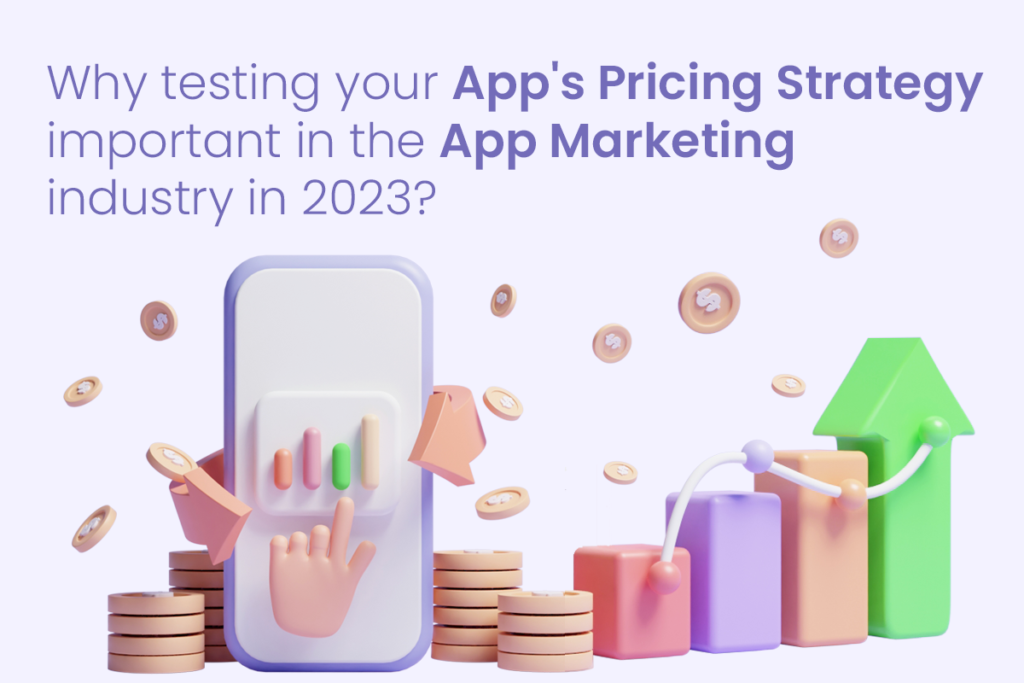
Why testing your app pricing strategy is important in the app marketing industry in 2023
As a team of expert app marketers, we cannot overemphasize the importance of regularly testing pricing strategies for higher app earnings in the app marketing industry. It is a well-known fact that the app market is extremely competitive, with thousands of new apps being developed and launched every day. To stand out in this crowded space, app marketers need to employ the right strategies to attract and retain users, and pricing strategy is one of the most important.
Pricing strategy is not just about setting the right price for your app, but also about understanding your target market, their spending habits, and their willingness to pay for your app. It is important to keep in mind that the price of your app will play a significant role in determining its perceived value, which will in turn affect its popularity and profitability. Therefore, app marketers need to continually test and refine their pricing strategies to ensure that they are maximizing their earnings.
Here are some of the reasons why it is best to regularly test pricing strategy for higher app earnings:
- Keep Up with Market Trends
The app market is constantly evolving, with new trends emerging all the time. What worked a few years ago may not work today, which is why it is important to stay up-to-date with the latest market trends. Regularly testing your pricing strategy can help you stay ahead of the competition and adapt to changing market conditions.
For example, if you notice that your competitors are offering similar apps at lower prices, you may need to adjust your pricing strategy to remain competitive. Alternatively, if you notice that users are willing to pay more for certain types of apps, you can adjust your pricing accordingly to maximize your earnings.
- Understand User Behavior
Understanding user behavior is key to developing an effective pricing strategy. By testing different pricing models, you can gain valuable insights into how users respond to different price points. For example, you may find that users are more likely to purchase your app if you offer a limited-time discount, or that they are more likely to upgrade to a premium version if it offers additional features or functionality.
By understanding user behavior, you can tailor your pricing strategy to meet the needs and preferences of your target market, which can help you attract and retain more users and increase your earnings.
- Optimize Revenue Streams
One of the biggest advantages of regularly testing your pricing strategy is that it allows you to optimize your revenue streams. By experimenting with different pricing models, you can identify the most effective ways to generate revenue from your app.
For example, you may find that offering in-app purchases or subscriptions generates more revenue than charging a one-time fee for your app. Alternatively, you may find that a combination of different revenue streams, such as advertising and in-app purchases, is the most effective way to maximize your earnings.
By optimizing your revenue streams, you can increase your earnings and improve the overall profitability of your app.
- Increase User Engagement
Regularly testing your pricing strategy can also help you increase user engagement. By offering different pricing options, you can encourage users to interact with your app in different ways. For example, you may offer a free version of your app with limited features to encourage users to try it out, and then offer a premium version with additional features for those who want to upgrade.
By increasing user engagement, you can improve user retention and encourage users to spend more time and money within your app, which can ultimately increase your earnings.
- Respond to User Feedback
Finally, regularly testing your pricing strategy can help you respond to user feedback. By analyzing user reviews and feedback, you can identify areas where your app can be improved and adjust your pricing strategy accordingly.
For example, if users are complaining about the price of your app, you may need to lower your prices to remain competitive. Alternatively, if users are asking for additional features or functionality, you may need to adjust your pricing strategy to reflect the added value of these features.
By responding to user feedback, you can improve the overall user experience and increase user satisfaction, which can lead to higher user retention and increased earnings.
Tips for Testing Your Pricing Strategy
Now that we’ve established why it’s important to regularly test your pricing strategy, let’s discuss some tips for how to do it effectively.
- Start with a Hypothesis
Before testing your pricing strategy, it’s important to have a hypothesis or a set of assumptions that you want to test. This will help you stay focused and ensure that you are testing specific variables.
For example, you may hypothesize that users are willing to pay more for a premium version of your app if it offers additional features or functionality. You can then test this hypothesis by offering a premium version of your app with added features and comparing the results to your baseline.
- Test One Variable at a Time
When testing your pricing strategy, it’s important to only test one variable at a time. This will help you isolate the effects of each variable and ensure that your results are accurate.
For example, if you want to test the impact of different pricing models on user engagement, you may want to test a free version of your app with in-app purchases against a premium version of your app with a one-time fee. By only testing one variable at a time, you can ensure that your results are accurate and actionable.
- Use A/B Testing
A/B testing is a powerful tool for testing pricing strategies. It involves randomly assigning users to different versions of your app and comparing the results.
For example, you may offer a limited-time discount to a randomly selected group of users and compare their behavior to a control group that did not receive the discount. By comparing the behavior of the two groups, you can determine the impact of the discount on user engagement and revenue.
- Monitor User Feedback
User feedback is an important source of information when testing your pricing strategy. By monitoring user reviews and feedback, you can identify areas where your app can be improved and adjust your pricing strategy accordingly.
For example, if users are complaining about the price of your app, you may need to adjust your pricing to remain competitive. Alternatively, if users are asking for additional features or functionality, you may need to adjust your pricing to reflect the added value of these features.
Conclusion
Regularly testing your pricing strategy is essential for maximizing your earnings in the app marketing industry. By staying up-to-date with market trends, understanding user behavior, optimizing your revenue streams, increasing user engagement, and responding to user feedback, you can develop a pricing strategy that meets the needs and preferences of your target market.
Remember to start with a hypothesis, test one variable at a time, use A/B testing, and monitor user feedback to ensure that your results are accurate and actionable. With the right pricing strategy in place, you can stand out in the crowded app market and achieve long-term success.
Please feel free to Contact Us in case you need any guidance regarding your app marketing needs.




0